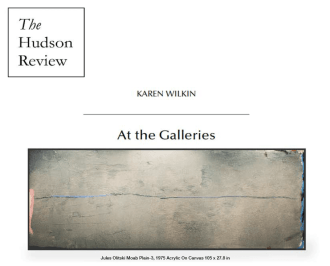
"Jules Olitski: On the Edge, A Decade of Innovation," at Leslie FeelY, was similarly revelatory. A fine selection of Olitski's delicately modu- lated paintings from the 1970s revealed his exploration of elusive surfaces, subtle hues, and tonal variations. Feely quotes Olitski as saying, ab out works of this kind, "I was trying to extend Rembrandt's use of flowing paint, his chiaroscuro, and just as much, his impasto into modern painting." In contrast to the disembodied expanses of sprayed-on, chromatic color that established the painter's reputation in the 1960s, his works of the 1970s test the ex pressive possibilities of richly inflected surfaces and subdued but rich color. At times, the thick, manipulated impasto (achieved with the most up-to-date acrylic paint technology of the time) be
comes like shallow relief. At other times, Olitski seems to be rethinking the implications of Cubist fragmentation, translated into giant sweeps and pushed fully toward abstractness. As always, the size and proportion of the intuitively adjusted fields are crucial, as are the occasional drawn lines that restate boundaries or trace paths across the canvas, altering the space and triggering multiple associations with everything from landscape to reclining figures. The paintings in "On the Edge" de m anded that we invest time to absorb their eloquent nuances. If we looked long enough, for example, surprising blushes of often seductive color eventually bloomed out of delicate grays and tans. As always, Oli tski here presented us with slowly yielding works whose apparent simplicity proved to encapsulate a lifetime's passionate thinking about the entire history of art and a lifetime's commitment to finding ways of translating that history into powerfully associative abstract language.